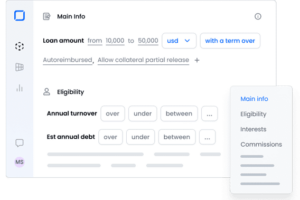Today’s banking customers expect more from their financial institutions. Mobile technology and apps have made it easier than ever for anyone to open an account, apply for a loan, or pay bills within minutes – all without having to speak to another person.
With customer needs rapidly evolving and expectations rising, banks and credit unions are left in a precarious position: evolve and innovate, or fall behind and suffer the consequences. However, legacy technology can hinder or totally block innovation, and the risk and cost involved in replacing these monolithic systems can make things even more challenging for teams. How can banks and credit unions create better experiences for customers and members? We discussed the answer to that very challenging question in a recent webinar.
Digital Customer Experiences, Redefined
Digital customer experiences (or “CX” for short), especially in banking, can make or break a customer’s trust in their bank. A regional bank can have over 1,500 customer journeys across business units and product lines. Those journeys represent an opportunity for banks and credit unions to reimagine and personalize their customer experiences. Customers expect not only a better experience from their bank, but they also expect a convenient, personalized experience.
But streamlining and optimizing these journeys is easier said than done. Legacy technology often stands in the way of any new, innovative ideas and change is slow-going at best. Unfortunately for banks, this means they may be missing out on opportunities such as embedded finance. Yet the longer banks and credit unions wait, the more neobanks and fintech giants will be able to move in.
Not All Banking CX Is Created Equal
Banks and credit unions must prioritize customer experience more than ever. While creating personalized, digital customer journeys sounds daunting; it can be done even with legacy technology. Fintech—and fintech enablement—bridge the gap between rigid, monolithic technology and nimble, low-code/no-code platforms that leverage a treasure trove of integrations and data sets to create seamless, tailored journeys.
Financial product management platforms allow any bank or credit union to expand its technological capabilities without replacing anything. Teams can also quickly launch or service any product they design, eliminating the need for outsourced tech talent. This truly puts banks in control of customer experience, allowing for more tailored, personalized journeys that reflect what consumers actually want.
Building Better Customer Journeys
So how can banks build these journeys? What capabilities do financial product managment platforms offer for creating an outstanding customer experience? And how do these capabilities help banks and credit unions keep up in the present market?
Leverage Pre-Built Features, Data, and Generative AI for Faster Launches
Next-generation financial product management platforms are designed to make launching and servicing products easy and straightforward. Instead of having to rely on outsourced tech talent or vendors, dealing with endless back-and-forth conversations, and sometimes waiting months at a time for updates, banks can be fully in control of their customer journeys and experiences.
Thanks to pre-built connectors, foundational AI APIs, product definitions, and data sets, anyone can quickly design a user-friendly journey to their exact specifications and needs. A low-code/no-code approach, coupled with AI and prebuilt journeys, also removes the barrier to entry, so anyone can access and build a new product without typing a single line of code. You can futureproof your CX strategy and create a transformative journey, all in the FintechOS platform.

Take Control of Back Office Servicing
Manual back-office processes can often cause delays in any customer’s journey, souring an otherwise good experience. However, financial product management platforms can change that with workflow automation.
In the FintechOS platform, for example, users can create new products with prebuilt servicing capabilities for loans, mortgages, BNPL, and more. These prebuilt capabilities eliminate otherwise old manual processes and back-office systems, with customization available for forms, model extensions, and workflows. The composability of a fintech enablement platform also allows banks to deploy only what they need when they need it.

Supplement Your Core
In the past, legacy technology and scattered data would completely hinder new innovations or product launches for banks and credit unions. The only solution was the risky and cost-prohibitive “rip and replace” methodology, which took years at a time. But next-generation financial product management platforms have changed that.
Instead of ripping out and replacing old systems, banks can extend their core to launch new products, reimagine old ones, and continuously service them. Banks can unify their data and leverage it through an integration-rich environment and API-first architecture to create more personalized offerings for their customers. Unlocking these data sets is just the start, however.
Accelerators within these platforms allow teams to build journeys using industry data models and connectors that cover a wide range of use cases. Banks can create and launch new products their customers will love using their existing technology without the risk of replacing anything.

Create Better Digital Journeys Without Replacing Anything
Consumer expectations have shifted, and it’s up to banks to keep up with them. New technologies like Generative AI and products like embedded finance present an opportunity for banks to create more personalized, tailored customer experiences that offer consumers exactly what they expect and want.
But when it comes to designing these customer journeys, legacy technology can get in the way. Banks then must choose between completely shutting down all innovation to replace their core systems in one fell swoop or relying on external teams and vendors at the expense of having much less control over their own products.
Next-generation financial product management can change that, extending a bank’s core and capabilities. Anyone can design a truly user-friendly experience, putting banks back in control of their product management. This enables banks to keep up with the rapidly evolving expectations of their customers and consumers at large.
Want to explore this topic more in-depth? Watch our webinar on customer experience creation on demand!

Kristen Tally Kristen is the Account-Based Marketing Manager at FintechOS. With 6 years of digital marketing under her belt, Kristen has worked with startups and established brands alike to support pipeline growth using paid media, paid search, SEO, and live content. When she's not working, you can find her at a coffee shop, scouting new restaurants to try out, or at the local park with her dog.








